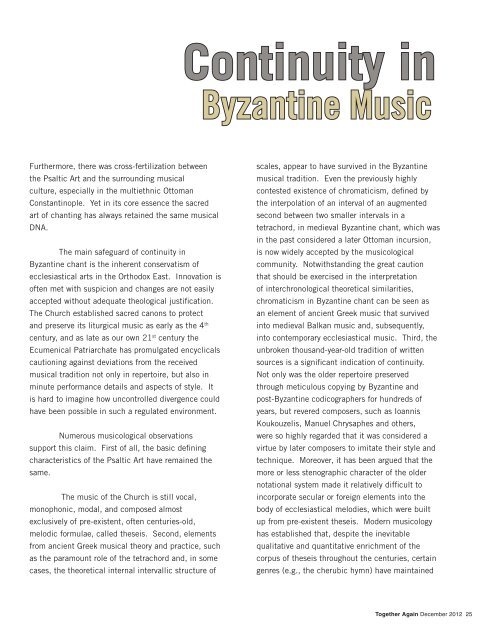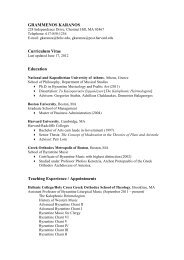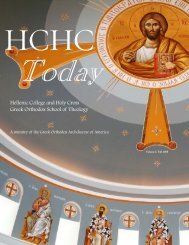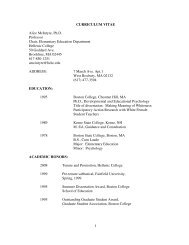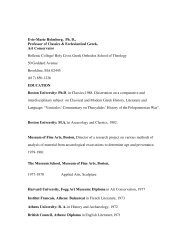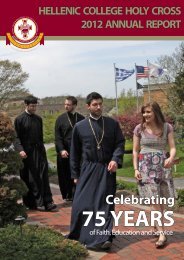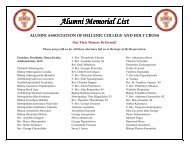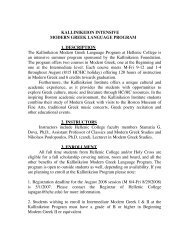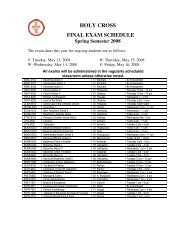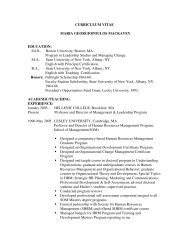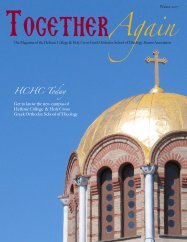Celebrating Sacred Art - Hellenic College
Celebrating Sacred Art - Hellenic College
Celebrating Sacred Art - Hellenic College
You also want an ePaper? Increase the reach of your titles
YUMPU automatically turns print PDFs into web optimized ePapers that Google loves.
Continuity in<br />
Byzantine Music<br />
Furthermore, there was cross-fertilization between<br />
the Psaltic <strong>Art</strong> and the surrounding musical<br />
culture, especially in the multiethnic Ottoman<br />
Constantinople. Yet in its core essence the sacred<br />
art of chanting has always retained the same musical<br />
DNA.<br />
The main safeguard of continuity in<br />
Byzantine chant is the inherent conservatism of<br />
ecclesiastical arts in the Orthodox East. Innovation is<br />
often met with suspicion and changes are not easily<br />
accepted without adequate theological justification.<br />
The Church established sacred canons to protect<br />
and preserve its liturgical music as early as the 4 th<br />
century, and as late as our own 21 st century the<br />
Ecumenical Patriarchate has promulgated encyclicals<br />
cautioning against deviations from the received<br />
musical tradition not only in repertoire, but also in<br />
minute performance details and aspects of style. It<br />
is hard to imagine how uncontrolled divergence could<br />
have been possible in such a regulated environment.<br />
Numerous musicological observations<br />
support this claim. First of all, the basic defining<br />
characteristics of the Psaltic <strong>Art</strong> have remained the<br />
same.<br />
The music of the Church is still vocal,<br />
monophonic, modal, and composed almost<br />
exclusively of pre-existent, often centuries-old,<br />
melodic formulae, called theseis. Second, elements<br />
from ancient Greek musical theory and practice, such<br />
as the paramount role of the tetrachord and, in some<br />
cases, the theoretical internal intervallic structure of<br />
scales, appear to have survived in the Byzantine<br />
musical tradition. Even the previously highly<br />
contested existence of chromaticism, defined by<br />
the interpolation of an interval of an augmented<br />
second between two smaller intervals in a<br />
tetrachord, in medieval Byzantine chant, which was<br />
in the past considered a later Ottoman incursion,<br />
is now widely accepted by the musicological<br />
community. Notwithstanding the great caution<br />
that should be exercised in the interpretation<br />
of interchronological theoretical similarities,<br />
chromaticism in Byzantine chant can be seen as<br />
an element of ancient Greek music that survived<br />
into medieval Balkan music and, subsequently,<br />
into contemporary ecclesiastical music. Third, the<br />
unbroken thousand-year-old tradition of written<br />
sources is a significant indication of continuity.<br />
Not only was the older repertoire preserved<br />
through meticulous copying by Byzantine and<br />
post-Byzantine codicographers for hundreds of<br />
years, but revered composers, such as Ioannis<br />
Koukouzelis, Manuel Chrysaphes and others,<br />
were so highly regarded that it was considered a<br />
virtue by later composers to imitate their style and<br />
technique. Moreover, it has been argued that the<br />
more or less stenographic character of the older<br />
notational system made it relatively difficult to<br />
incorporate secular or foreign elements into the<br />
body of ecclesiastical melodies, which were built<br />
up from pre-existent theseis. Modern musicology<br />
has established that, despite the inevitable<br />
qualitative and quantitative enrichment of the<br />
corpus of theseis throughout the centuries, certain<br />
genres (e.g., the cherubic hymn) have maintained<br />
Together Again December 2012 25


